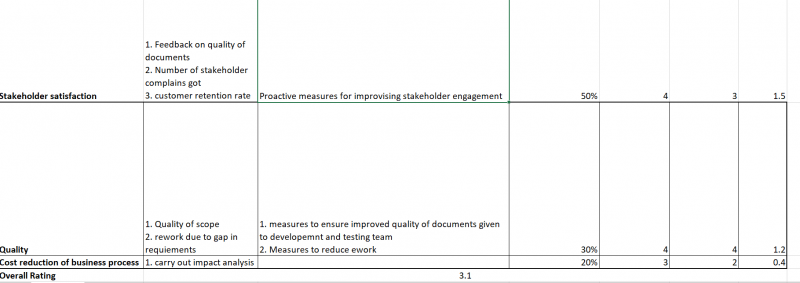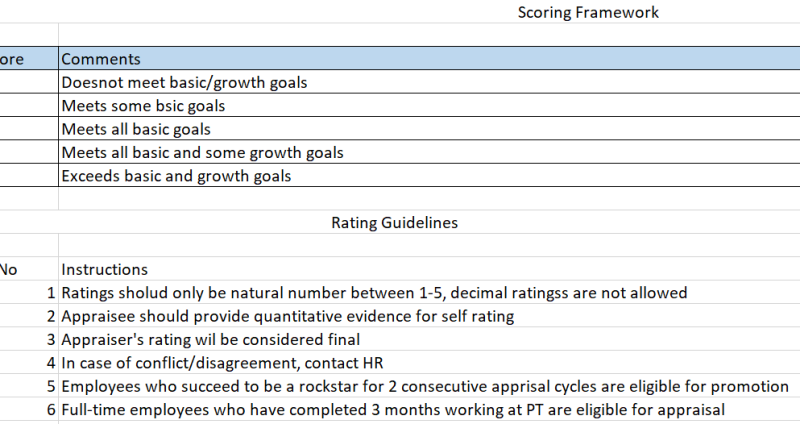Dashboard › Forums › Assignment discussion › PMS Implementation
Tagged: PMS
PMS Implementation
Posted by Raksha on February 23, 2024 at 4:24 PMHi,
I need guidance on how to implement a performance appraisal system in a start up, I am specifically looking for the process flow, how to collate everything and any relevant files, docs etc
Thanks in advance.
Regards,
Raksha
Raksha replied 1 year, 9 months ago 3 Members · 7 Replies- 7 Replies
Hey @raksha ,
Thank you for reaching out for advice and guidance to the CHRMP community.
Begin by setting Clear Goals: Begin by setting clear goals for organisation.
Break It Down: Once you’ve got your big-picture goals, break them down into individual objectives.
Choose Your Tools: Decide on how you’ll measure these goals. There are many tools out there – 360-degree feedback, self-evaluations, or manager assessments.
Give Feedback: Regular check-ins are crucial. Think of them as stopping points along your treasure hunt where you can reassess your map, make sure everyone is healthy, and adjust the sails if needed.
Nurture and Grow: Identify gaps and areas the employees can grow. Offer training, workshops, or mentoring to help them polish their skills.
What was missing: When goals are met, celebrate! And when they’re not, gather around, discuss what went wrong, and how you can avoid those storms in the future.
Keep Evolving: Your startup will grow and change, and so should your appraisal system. Regularly review and tweak it to ensure it remains relevant. It’s like updating your treasure map based on the new landscapes you discover.
For the nitty-gritty, such as setting performance benchmarks and offering support to bridge performance gaps, there are many tools and recorded sessions. It suggests a structured approach involving planning, monitoring, developing, and rewarding efforts towards organizational goals.
Would love to hear how others are navigating this journey. Any tools or practices that have been a game-changer for your startup?
Hello Raksha,
Thank you for initiating a discussion on a challenge which I believe a lot of our other participants must also be facing.I have answered the query leveraging my own experience of implementing a performance management system and also assisting other organisations to do so.
I would request your attention and patience as the response is detailed.
Hope this gives you a comprehensive insight on how to establish a performance management system and appraisal process in startups.
For the sake of convenience I have divided it into 2 activities:
• SETTING UP OF PERFORMANCE MANAGEMENT SYSTEM
• IMPLEMENTATION OF PERFORMANCE APPRAISAL
You may set up the above up following these steps. Please ignore the step if it’s already done.
SETTING UP OF PERFORMANCE MANAGEMENT SYSTEM
Step 1: Define the vision, mission and value system of your organisation. This is extremely important before you do anything else. This has to be done with the founders and other members of the leadership team.
In this discussion, you should also discuss the performance management system that should suit your organisation. Generally startups believe in faster growth and acceleration on business goals. Please remember to align this system with the culture of the organisation. You may either chose MBO or Balanced Scorecard or any other performance management system.
Step 2: Define the timespan after which the appraisal will be carried out. You should also decide on the appraisal method. Ensure that the method that you chose is easy to understand, implement and calculate. A suitable method for startups would be to have a 180 degree review between the manager and subordinate and a 360 degree feedback for each member.
The score/ratings achieved after 180 degree review will be used for promotions, salary hikes, etc.
The scores/ratings achieved after 360 degree will be used for creating developmental or learning initiatives for individuals.
Step 3 : Now set the goals that must be achieved within the decided time frame. Please remember that while doing so, the mission can be further broken down to create yearly achievable business objectives and targets.
Step 4: The goal setting activity must align to the performance management system chosen by your organisation. You can either chose between Smart Goals or OKRs. Try and make goal setting a collaborative effort that involves the participation of the managers and the team members.
Step 5 : The goals should be set in the following order: Departmental Goals cascaded to form Team Goals(if applicable).The ownership of these Team goals is further distributed among the team members to form Individual Goals.
Step 6: Each goal must be measured through a metric i.e Key Performance Indicator(KPI).The KPI will present the actual movement on the achievement of the goal to the team and individual. Remember to derive the KPI from the goals set only. Please refrain from using any unrelated metric to measure the progress on the goals.
Step 7: Implement periodic feedback sessions between the manager and the team members. It is good to standardise the frequency for such sessions in teams. As a HR, you must be aware of this frequency and accordingly initiate the conversations at the stipulated time.
The goals that must be discussed must be left to the discretion of the respective managers and their team members.
Step 8: As the HR you must also discuss the rating criteria and rating scale with the leadership team and the HODs. The corresponding action for each rating must also be finalised on in that discussion.
Step 9 : You as the HR must then create a performance management policy for the organisation including the above. This must be communicated to all the employees.
IMPLEMENTATION OF PERFORMANCE APPRAISAL
Step 1: Create the feedback forms for managers, individuals and peers. Create sections for evaluating KSA as required for different roles and departments. Please discuss this with the reporting managers and the HODs and get the list of the KSA required for evaluation.
The statements in the manager and individual feedback form should be the same. The only difference will be the way it is written.
Let’s say that the criteria for evaluation is target achievement.
In the manager’s evaluation form for the team member it would say, The team member has been able to achieve the set targets consistently.
In the Self individual form, the same evaluating criteria must say ,I have achieved the set targets consistently.
Step 2 : Create a timeline for the entire appraisal process. This timeline should include the milestones and the dates. Have a gap of minimum one month between the commencement and completion of the entire process.Some of the milestones that can be tracked on this timeline can be
• Submission of the completed feedback forms by all
• Appraisal discussion between manager and subordinates
• Collation of Data
• Calculation of Data
• Mapping of appraisal data with rating metric
• Discussion with respective reporting managers
• Discussion with the leadership
• Announcement of results
This timeline will be used for internal tracking and adherence. It needn’t be shared with the all.
Step 3: Inform the employees about the commencement date and the completion date of the appraisal cycle at least a month before the date of implementation.
Step 4: Circulate the feedback form a day before the commencement of appraisal. Please also send out a communication to all regarding how to fill the appraisal forms. Share the feedback forms in the following manner
• For Managers – Self and Team
• For Team Members – Self, Manager, Peers
Step 5: Ensure that the timelines of the appraisal cycle is adhered to.
Step 6 : Collate the data and calculate the individual scores.
Step 7 : Create department/team wise scores and map it to the rating metrics. Then identify the applicable action for each score.
Step 8 : Discuss this data with the respective team managers. Post this share this data with the leadership team.
Step 9 : Announce the results for everyone individually and the effective date for the application of the promotions, salary hikes, PIP as the case may be.
Step 10: As the HR you must create a SOP for better speed and efficiency in the entire process.
There are a number of PMS(Performance Management System) that are available but I would suggest that you should initially use Excel to implement the Performance Appraisal method primarily for two reasons:
1. It is a tool everyone is familiar with and hence it would be easy for everyone to use it properly.
2. As your organisation matures, everyone will gain a better of the business goals and identify how to measure the progress on that. It would be cost effective to opt for a PMS then.
Thanks Sunny Sir for your inputs , it is very helpful
Thanks Indrani Maám for the detailed explanation. This certainly guides me on the process flow.
So we will go ahead with the 180-degree appraisal (Superior- subordinate), currently I have the scoring framework and scoring sheet(attached sample). So as a first step, I should circulate the scoring sheet to the team. Once they fill it and send back, the overall rating should be mapped against the salary slab? To map the overall rating against the revision salary slab, I can create a matrix or table where each row represents a salary slab and each column represents a range of overall ratings. Then, I can determine the corresponding salary slab for each overall rating based .
Is my understanding correct? somehow I am unable to put together everything-would have a sheet or some doc to help pull this together.
I would really be grateful for your help
Looking forward to your response
Regards,
Raksha
Hello Raksha,
Thank you for sharing this information.
You can implement the 180 degree review between the manager and the subordinate.
Let me help you with more detailed information about the performance factors, weightage, rating scale and scoring framework that you can use to consolidate the appraisal process.
PERFORMANCE FACTORS :
Performance factors refer to the specific criteria or attributes used to assess an individual’s performance in their role within an organization. These factors are used to measure an employee’s effectiveness, competency, and contribution to achieving organizational goals.
Performance factors are typically aligned with the responsibilities, objectives, and key performance indicators (KPIs) of the employee’s role and may vary depending on the nature of the job and the organization’s priorities.
Performance factors can be standardised for a team or department. This standardisation might vary from team to team/dept to dept depending on their contribution in achieving organisational goals.
Performance Factors for a team can be divided into technical factors(core to the role) and behavioural factors.
The Behavioural factors can be aligned to the organisational values and can be standardised for the entire organisation.
You may distribute weightage for these two factors in the following way : Technical (60%-70%) & Behavioural(40%-30%)
WEIGHTAGE:
Weightage refers to the relative importance or priority assigned to different performance factors or criteria. When performance factors are weighted, it means that each factor is assigned a numerical value or percentage that reflects its significance in the overall evaluation process.
By assigning different weights to performance factors, organizations can emphasize certain aspects of performance that are particularly critical to success in a specific role or within the organization as a whole.
The weightage assigned to the performance factors must depend on the role and the organisational goals that the role has to achieve.
The total weightage for all the performance factors should add up to 100%.
SCORING FRAMEWORK:
A scoring framework is a structured system used to assign numerical scores or ratings to various performance factors or criteria.
The numerical scores or ratings is left to the organisation’s discretion. It can be either 1(Poor) – 5 (Excellent) or Strongly Disagree(1) – Strongly Agree(4) for the performance factors.
The aggregate of all the scores is calculated. This number is then mapped to the rating scale to identify where an individual’s performance falls.
RATING SCALE:
A rating scale categorizes performance into broader levels or categories and assigns a single rating based on where the individual’s performance falls within those categories.
The rating scale is left to the discretion of the organisation. It can be
• Unsatisfactory/Needs Improvement: Performance consistently falls below expectations and requires significant improvement. Employee fails to meet job requirements and may require additional training or support.
• Below Expectations: Performance is below satisfactory levels and requires improvement in several areas. Employee demonstrates weaknesses in some aspects of job performance but may also show strengths in other areas.
• Meets Expectations/Competent/Proficient: Performance meets the established standards and expectations for the role. Employee consistently demonstrates competence and effectiveness in most areas of job performance.
• Exceeds Expectations/Highly Effective: Performance consistently exceeds expectations and demonstrates a high level of competency and effectiveness. Employee consistently goes above and beyond job requirements and achieves exceptional results.
• Outstanding/Exceptional: Performance far exceeds expectations and consistently demonstrates exceptional competence, initiative, and contribution. Employee sets a high standard for performance and significantly contributes to the success of the team and organization.
These can be further described in details.
Each of these scales can be assigned a numerical range. This numerical range should be aligned to the scoring framework. It should have a minimum and a maximum limit.
Please let me know if you have any more questions !
Thanks a lot for responding Maám.
Can I get your mail id please (in case I have doubt during the process).
Few questions:
1. Should I start the process by sending the appraisal form to everyone?
2. After I receive the filled forms, the final ratings should be seen? so if on a scale of 1-5-the rating for an employee is 3 and if 3 corresponds to an 8 percent hike, the salary should be revised accordingly?and then the appraisal letters should be sent out, along with making changes in the database etc about the revised salary?
Thank
Regards,
Raksha
You are welcome Raksha!
Please find the answers to your questions:
1. Should I start the process by sending the appraisal form to everyone?
Yes you should initiate the appraisal process by sending out the relevant appraisal forms to the managers, subordinates and other participants of the appraisal process.Before that I am assuming that you have communicated how the process will be along with the timelines.
2. After I receive the filled forms, the final ratings should be seen? so if on a scale of 1-5-the rating for an employee is 3 and if 3 corresponds to an 8 percent hike, the salary should be revised accordingly?and then the appraisal letters should be sent out, along with making changes in the database etc about the revised salary?
Yes, if the final rating received by the employee is 3 and if it corresponds to 8% hike, then the salary must be revised accordingly.
The appraisal letters must be sent out mentioning the results of the appraisal process and the corresponding hike.The effective date of implementing the new hike must also be mentioned.
Generally organisations implement the new salary from the following financial year.So the database gets adjusted accordingly by then.
In case you seek any further assistance, please feel free to write to me at indrani.nath@rippleslearning.com
Thank You!
Thanks Maám
Another question-Before that I am assuming that you have communicated how the process will be along with the timelines.
No, I have not done it-would you have a process plan in excel etc that I can use as reference please?
Regards,
Raksha
Log in to reply.


